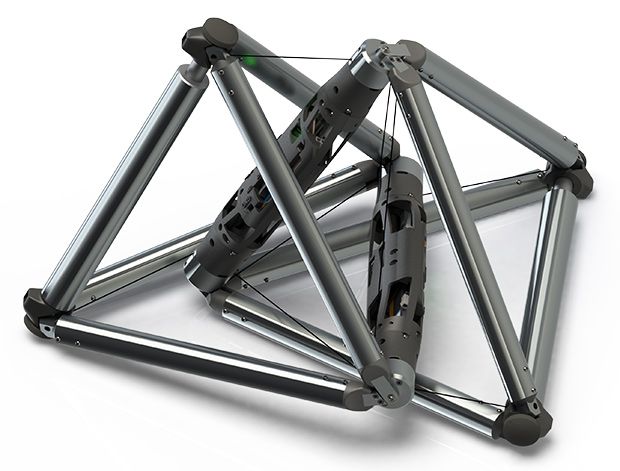 I would like to take the opportunity to highlight the work of Jeff Friesen, one of the most talented robot designers I have had the pleasure to work with! He is a PhD student at UCSD in the Coordinated Robotics Lab, who has been working with our lab both as a summer student, and as a central part of our team for the last few years with the support of a NASA Space Technology Research Fellowships (NSTRF). Jeff is delightfully talented at mechatronic design and controls algorithms, and has built a number of very innovative tensegrity robots over the years. With his rapid iteration on building new robots, he has encountered and addressed a number of unique design challenges that are common to many tensegrity robots, and a number of his ideas have been integrated into our current SUPERball 2.0 robot designs (which he also participated in developing).
I would like to take the opportunity to highlight the work of Jeff Friesen, one of the most talented robot designers I have had the pleasure to work with! He is a PhD student at UCSD in the Coordinated Robotics Lab, who has been working with our lab both as a summer student, and as a central part of our team for the last few years with the support of a NASA Space Technology Research Fellowships (NSTRF). Jeff is delightfully talented at mechatronic design and controls algorithms, and has built a number of very innovative tensegrity robots over the years. With his rapid iteration on building new robots, he has encountered and addressed a number of unique design challenges that are common to many tensegrity robots, and a number of his ideas have been integrated into our current SUPERball 2.0 robot designs (which he also participated in developing).
While some of Jeff’s most innovative and impactful work is waiting for publication, I would like to highlight one of the robots that Jeff developed over a couple years and through two design iterations,

Jeff Friesen’s Duct Climbing Tetrahedral Tensegrity (DuCTT) Robot
namely the Duct Climbing Tetrahedral Tensegrity (DuCTT) Robot. The intent of the robot was to develop a machine which could climb and maneuver through tight constrained spaces, such as ducts in buildings, or small tunnels or natural crevasses. The challenge is to be able to both lift and move in a vertical shaft, while also being able to turn corners. Because most duct systems (and all natural tunnels) have complex internal features, simply using wheels to roll along is not sufficient, but instead requires that the system be able to lift and place limbs of some sort. In attempting to address all these requirements with more traditional designs, past efforts have generally resulted in overly complex mechanisms which are too heavy or fragile for real use.
As is often the case, designing a robot with tensegrity principles in mind, Jeff was able to develop a simple and light weight solution which can climb and turn as required. The system is composed of 2 tetrahedral sections, connected by a network of cables, which enable the sections to inchworm up the shaft. In fact, there could be as many modules as needed, if a longer robot with different payloads or sensors was required. Each tetrahedron has a linear motor in one of the bars to control the width of the tetrahedron, allowing it to press and hold firmly against the shaft, or tuck in compactly to move around an obstacle. This next video shows DuCTT climbing up out of a vertical shaft.
Since it is a bit hard to see all the details of how the robot moves, the next animated video (based on the first generation robot) shows how the inchworm action occurs.
Finally, the following video shows DuCTT exercising its full range of motion, which shows how it could turn a corner within a duct system.
For more information about this robot, see the following papers:
Jeffrey Michael Friesen, Michael Fanton, Paul Glick, Pavlo Manovi, Alexander Xydes, Thomas Bewley, Vytas SunSpiral, “The Second Generation Prototype of A Duct Climbing Tensegrity Robot, DuCTT”, In proceedings of 2016 IEEE International Conference on Robotics and Automation, (ICRA2016), May 2016, Stockholm, Sweden. Download PDF.
Jeffrey Michael Friesen, Alexandra Pogue, Thomas Bewley, Mauricio de Oliveira, Robert E. Skelton, Vytas SunSpiral, “A Compliant Tensegrity Robot for Exploring Duct Systems”, In Proceedings of International Conference on Robotics and Automation (ICRA), Hong Kong, June 2014 Download PDF.




0 Responses
Stay in touch with the conversation, subscribe to the RSS feed for comments on this post.